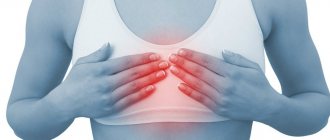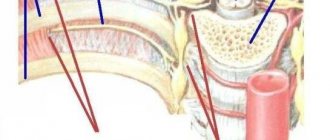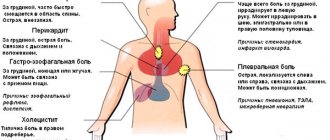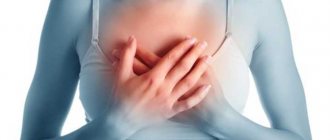What does it mean if there is pressure in the chest?
The chest is a cone-shaped part of the body, having a somewhat compressed shape. It contains the respiratory organs, heart muscle, thyroid gland, etc.
Pathologies leading to the development of chest pain are very diverse and can affect any system localized in a given area. To differentiate symptoms, a comprehensive assessment of the patient's condition is necessary.
When there is pressure in the chest, the following parameters are important:
- localization of pain;
- nature of pain;
- duration;
- associated symptoms;
- how the sensations are relieved;
- after which the pain intensifies, etc.
In the middle
Localization of sensations is an important diagnostic sign. If there is pressure in the middle of the chest, then this may indicate diseases such as:
- Myocardial infarction. The reasons why there is pressure in the chest include one of the forms of ischemic heart disease, which leads to the necrosis of the muscle tissue of the heart. The main cause of MI is considered to be a lack of blood supply.
- Aortic aneurysm dissection. The condition is a consequence of pathological changes in the aorta resulting from various causes (atherosclerotic or inflammatory processes, hereditary changes, trauma, etc.).
- Intercostal neuralgia. The main reason for the development of the condition is hypothermia. It is compression of the nerve roots between the ribs. It is not considered a dangerous disease, but it causes significant discomfort and impairs the quality of life.
- Pathologies of the skeletal system. If there is pressure on the chest, this may be a consequence of osteochondrosis, radiculitis, scoliosis, etc. These diseases affect bones and cartilage, leading to unpleasant sensations.
- Rheumatic diseases. Damage to the joints and bones also leads to pressure on the sternum. Among such pathologies are rheumatoid arthritis, rheumatism, etc.
- Neoplasms. If there is pressure on the chest, the reasons may be the development of a malignant or benign tumor. In some cases, metastases from lung, breast, and stomach cancer can grow, leading to pain.
- Consequence of injury. Chest pain can occur due to a fall, blow, or tissue rupture. In some cases, the injury can lead to dangerous conditions, such as a ruptured lung.
Table 1. Distinctive features of pathologies leading to pain in the middle of the chest
| Name | Associated symptoms |
| Myocardial infarction | Pain during a heart attack has no clear localization. The person experiences a burning sensation, there is pressure on his chest, and it is difficult to breathe. The sensations are prolonged, not relieved by nitroglycerin, and often radiate to the lower jaw or arm. The patient feels a strong fear of death. |
| Aneurysm dissection | Pressing, tearing sensations. Blood pressure and pulse decrease, loss of consciousness is possible. Pallor, shortness of breath. |
| Intercostal neuralgia | The sensations are clearly localized and become aggravated with increased activity, coughing, and deep breathing. Not controlled by nitrates. There is strong pressure in the chest, the condition is observed around the clock, and intensifies during palpation. |
| Diseases of the skeletal system | Feeling of stiffness, swelling of the damaged area, increased meteosensitivity, increased sensations during activity. Treated with painkillers. |
| Rheumatic pathologies | Weakness, fatigue, joint pain, rheumatoid nodules, ring-shaped erythema. |
| Neoplasms | If there is pressure on the chest, the cause may be bone/tissue sarcoma. Pathologies are characterized by anemia, weakness, irritability, and fever. |
This is not a complete list of probable causes of pressing pain in the anterior part of the sternum. It is very difficult to diagnose on your own; it is recommended to visit a specialist.
Left
Most people believe that if there is pressure in the chest on the left, then this is certainly a pathology of the cardiovascular system. In practice, the manifestation can be triggered by a number of diseases. In particular:
- Angina pectoris. The pain is pressing, squeezing, burning. Localized in the heart area, in rare cases in the anterior part of the sternum. Other forms of IHD can lead to similar sensations. The condition can occur at any time of the day. In some patients, angina pain is recorded only in a horizontal position. The pathology is called resting angina.
- Pericarditis. An inflammatory pathology affecting the pericardium (heart tissue).
- Pulmonary embolism. It is a disruption of blood flow due to a blood clot. The life-threatening condition often leads to death in a short time.
- Pleurisy. It is an inflammatory lesion of the pleura (lining of the lungs).
- Gastrointestinal diseases. Pain in a number of pathologies can spread to the left side of the chest.
Table 2. Distinctive signs of pathologies leading to pain in the left side of the sternum
| Name | Associated symptoms |
| Angina pectoris | The pressure is especially strong on the left side after stress or activity. The sensations usually affect the epigastric region and can lead to discomfort in the head area. The attack is provoked by overeating, hypothermia, and increased blood pressure. Treated with nitroglycerin. |
| Pericarditis | The pressing pain increases gradually. In some cases it appears suddenly and pronounced. Peripheral edema, swelling of the veins in the neck, and ascites are observed. |
| Thromboembolism | Other manifestations may be absent. In some cases, tachycardia, loss of consciousness, cough, fever, and hemoptysis are observed. |
| Pleurisy | Presses on the chest, making it difficult to breathe. Fever, swelling of the neck veins, shortness of breath. |
| Gastrointestinal diseases | Localization on the left and in the epigastric region. Increased pain immediately after eating food or when feeling hungry. Gastrointestinal disorders. |
If there is pressure on the left side, then the pathologies described above are also likely:
- presence of neoplasms;
- pathologies of bones, joints, cartilage;
- mechanical damage;
- intercostal neuralgia, etc.
If you have pain on the left side, you do not need to make an appointment with a cardiologist. The initial appointment is carried out by a general practitioner, who will make a preliminary diagnosis and, if necessary, refer you to a specialist: neurologist, rheumatologist, gastroenterologist, etc.
On right
The cause of pressure on the right can be any of the above diseases. Pain may indicate:
- right-sided pneumonia (pneumonia);
- infectious diseases of the upper respiratory tract;
- oncological diseases;
- lesions of the skeletal system;
- neuralgic pathologies, etc.
Often there is pressure on the right side due to muscle strain or hypothermia. Systematic paroxysmal pain is a serious reason for taking action.
Treatment
Help before diagnosis
Heaviness in the chest occurs when various organs and systems are affected, so self-medication at home is unacceptable and is fraught with the progression of the underlying disease and the development of complications. Patients experiencing chest discomfort are advised not to delay contacting a therapist. If squeezing pain is felt in the chest, the person experiences suffocation, febrile fever, and requires emergency medical attention.
Conservative therapy
Treatment measures are selected after identifying the causes of the condition. Heaviness in the chest does not require special symptomatic therapy and disappears after eliminating the underlying pathology. All patients are prescribed a gentle motor regimen, maximum limitation of stress and traumatic factors. Medicinal effects include drugs from the following pharmacological groups:
- Antianginal agents
. Used in combinations for long-term therapy of coronary heart disease. They are supplemented with antiplatelet agents to prevent myocardial infarction and thrombosis. Nitrates are recommended to relieve angina attacks. - Anti-inflammatory drugs
. Nonsteroidal anti-inflammatory drugs are indicated for myocarditis and pericarditis, acute respiratory diseases. They act pathogenetically and also relieve discomfort and pain. If nonsteroidal drugs are ineffective, corticosteroids are taken. - Antibiotics
. Antimicrobial drugs are prescribed for pneumonia, pleurisy, purulent bronchitis as etiotropic treatment. Penicillin antibiotics are effective for inflammatory lesions of the heart due to rheumatism. To treat tuberculosis, 3-4 specific drugs are combined. - Antiallergic drugs
. Leukotriene receptor antagonists and mast cell membrane stabilizers are used for basic therapy of bronchial asthma. Classic antihistamines are used as pathogenetic therapy for many inflammatory processes with an allergic component. - Metabolic drugs
. To improve the delivery and utilization of oxygen in the myocardium under conditions of ischemia, it is necessary to take cytoprotectors. Therapy is enhanced with ascorbic acid and B vitamins, which accelerate metabolic processes in the body.
Reasons why it’s hard to breathe and not enough air
Breathing disorders are scary and make you think about your own health. If there is pressure in the chest and it is difficult to breathe, then you should not panic. It will only make the situation worse.
Possible causes (in addition to those listed above):
- Cerebral atherosclerosis. Pathology expressed in disturbance of blood flow of cerebral vessels due to blockage by atherosclerotic plaques. Characterized by increased blood pressure, heart rhythm disturbances, and tinnitus. Nitroglycerin helps relieve the condition.
- Acute gastritis. An inflammatory disease leading to the death of the gastric epithelium. When the disease occurs, it can be difficult to breathe and puts pressure on the chest.
- Angina. The pain is accompanied by the principles of suffocation, enlarged tonsils, and redness of the throat. The sensations intensify with inhalation and movement.
Pressure and difficulty breathing in diseases such as:
- myocardial infarction, cardiogenic shock; angina pectoris, pericarditis, endocarditis, etc.;
- pulmonary thromboembolism;
- pneumonia, pneumothorax, pleurisy;
- some forms of allergic reactions (Quincke's edema, anaphylactic shock);
- bronchial asthma;
- acute and chronic bronchitis; false croup; laryngitis, etc.
What to do?
The first rule when detecting pain is not to make a diagnosis yourself. If there is pressure, what to do:
- In case of prolonged or acute sensations, call an ambulance.
- While waiting for doctors, lie down with a bolster or pillow under your head.
- Loosen clothing and provide oxygen access.
- If you suspect that the sensations are due to heart disease, take a nitroglycerin tablet.
It is strictly forbidden to leave the patient unattended. If the situation is not critical, then you need to visit a doctor yourself as soon as possible.
Symptoms
The feeling of suffocation in the throat rarely comes alone.
Most often it is accompanied by other symptoms, sometimes no less unpleasant. Let's find out what these additional symptoms are. During a conversation, a persistent feeling of discomfort appears. It is difficult for a person to speak; there is a feeling that something in the throat is preventing this.
Feeling of a lump in the throat. Moreover, this “lump” not only interferes with speaking, but also makes it difficult to swallow and interferes with breathing.
In the video, the appearance of a lump in the throat:
When swallowing, painful sensations appear. Sometimes this even leads the patient to a complete refusal to eat due to too uncomfortable sensations during this process. Such refusal is especially dangerous for children, as it leads to weakness and rapid weight loss in the child.
You may feel heaviness in the back of your head, headache, and even loss of consciousness. The last symptom is expressed if there are disturbances in the circulatory system or central nervous system. Symptoms of pharyngeal neurosis may also include numbness and partial or complete absence of the pharyngeal reflex.
A feeling of numbness in the limbs is a symptom that is also sometimes associated with a feeling of suffocation. This symptom develops due to circulatory problems or neurological causes.
All additional symptoms can help the doctor make a diagnosis faster and more accurately and begin treatment. Therefore, at an appointment with a specialist, voice all the symptoms that worry you. And the doctor will be able to draw the appropriate conclusion from them.









